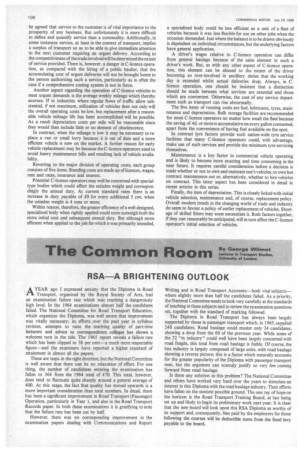RSA -A BRIGHTENING OUTLOOK
Page 108

If you've noticed an error in this article please click here to report it so we can fix it.
AYEAR ago I expressed anxiety that the Diploma in Road Transport. organized by the Royal Society of Arts. had an examination failure rate which was reaching a dangerously high level. In the 1964 examinations almost half the candidates failed. The National Committee for Road Transport Education, which organizes the Diploma, was well aware that improvement was vitally necessary: its efforts over the past year in syllabus revision, attempts to raise the teaching quality of part-time lecturers and advice to correspondence colleges has shown a welcome turn in the tide. The 1965 report reveals a failure rate which has been clipped to 38 per cent—a much more respectable figure—and the examiners have reported a higher standard of attainment in almost all the papers.
These are steps in the right direction, but the National Committee is well aware that there can be no relaxation of effort. For one thing, the number of candidates entering the examination has fallen to 364 from the 1964 total of 470. This total, however. does tend to fluctuate quite sharply around a general average of 400. At this stage. the fact that quality has moved upwards is a more important consideration than total numbers. In detail, there has been a significant improvement in Road Transport (Passenger) Operation, particularly in Year 1, and also in the Road Transport Records paper. In both these examinations it is gratifying to note that the failure rate has been cut by half.
However, there was no corresponding improvement in the examination papers dealing with Communications and Report Writing and in Road Transport Accounts—both vital subjects— where slightly more than half the candidates failed. As a priority. the National Committee needs to look very carefully at the standards of teaching in these subjects and to review the examination questions set, together with the standard of marking followed.
The Diploma in Road Transport has always been largely supported by those in passenger transport which. in 1965. supplied 248 candidates. Road haulage could muster only 34 candidates. showing a drop from the 60 of the previous year. While some of the 32 "in industry" could well have been largely concerned with road freight, this total from road haulage is feeble. Of course. the bus industry is largely composed of large units, with road haulage showing a reverse picture: this is a factor which naturally accounts for the greater popularity of the Diploma with passenger transport men, but the argument can scarcely justify so very few coming forward from road haulage.
Is there any solution to this problem? The National Committee and others have worked very hard over the years to stimulate an interest in this Diploma with the road haulage industry. Their efforts have fallen on the stoniest possible ground. The one ray of hope on the horizon is the Road Transport Training Board, at last being set up and likely to begin its preliminary work next year. It is clear that the new board will look upon this RSA Diploma as worthy of its support and, consequently, fees paid by the employers for those following the courses will be deductible sums from the fixed levy payable to the board.
































































































































































